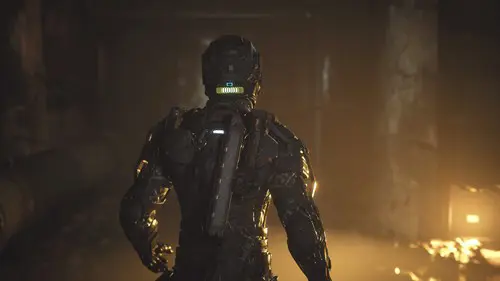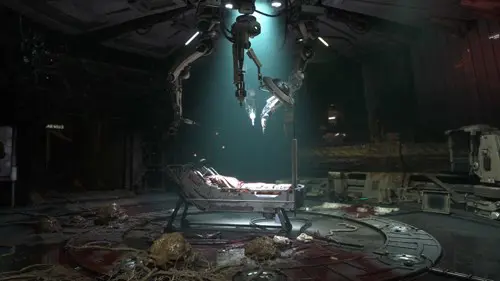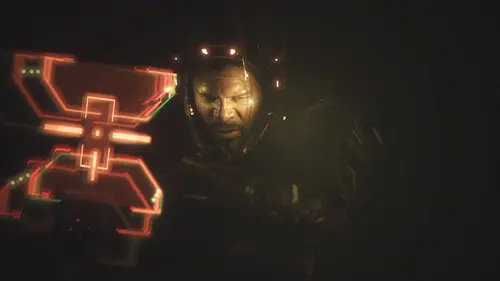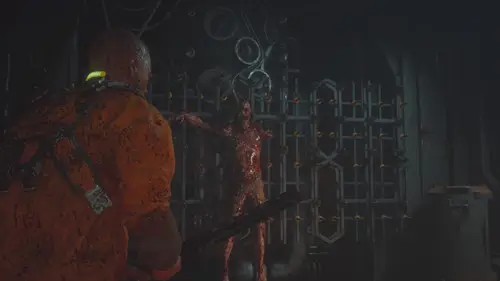The Callisto Protocol Review: "Death In Space"
Find out what we think of Striking Distance Studio's new sci-fi space surivial horror with this The Callisto Protocol review.

There is something just so horrifying about outer space. In the same way that many are so afraid of the ocean depths, the endless stretches of the cosmos seem to only naturally conjure up horrors beyond our own imagination's limits. We saw this excellently executed within 2008's Dead Space, but now Striking Distance Studios and its lead Glen Schofield are attempting to rekindle some sci-fi horror magic with a new IP - The Callisto Protocol. And while there are some frustrations that do end up holding the game back, The Callisto Protocol is a fantastic effort that revels in the guts and gore of this extraterrestrial adventure.
Prison Break

You play as Jacob Lee, an intergalactic cargo transporter that quickly gets caught up in a whole heap of trouble. A ship breach and then a crash on the mysterious planet of Callisto leads to Jacob's supposedly unwarranted arrest, and he is swiftly taken away to the panoptic death pit known as Black Iron Prison.
Not too soon after his arrival though, Jacob wakes up to chaos, as the prison is on lockdown, and has been overtaken by a strange virus that turns humans into terrifying creatures. It is up to you now to find a way out, and hopefully stumble upon some answers along the way too.
As you can imagine from the premise, The Callisto Protocol doesn't exactly have the most complex of narrative structures. It is a simple escape plot that is bound to have some twists, turns, and complications along the way, but it doesn't necessarily need to be much more than that. While a slow start does hamper progress a little bit, the majority of the game is spent progressing through the various horrific areas that are thrown at you, which acts as a perfect setup for many of the game's largest set pieces.
You get a good enough sense of all the characters and their part in the larger narrative, and there are some intriguing revelations by the time the credits roll, but I unfortunately never really got a sense of connection to Jacob, or any of the few other humans he comes across. The larger antagonists end up feeling rather one-dimensional, being nothing we haven't seen before in other survival horror titles, but it was generally nothing worse than an adequate - if not predictable - way to push the narrative forward.
Something that some players might not end up gelling with is that the story - or at least, most of the core background details - is conveyed through an abundance of audio logs found throughout the game. While at times I did find these to be a compelling diegetic way to progressively uncover the mystery of the game, more often than not it, unfortunately, served as a frustrating halt to the tension of the game.
Having to go through the effort of opening up the menu and finding each individual clip, only for it to last a mere few sections did get rather tedious, and at times I wished that I could have listened to them while continuing to play the game too, instead of being locked inside the codex screen. Furthermore, they are likely also very easy to simply gloss over as side content, when they are in the end vital pieces of the larger puzzle if you have any want to understand what is and has been going on in the game.
Caught In A Tight Spot

It is inevitable that the main draw of the game for most will be within the gameplay though, and between the fearful atmosphere and bone-crunching combat, there is thankfully plenty to love in The Callisto Protocol.
As the general drive of the narrative is escape, our protagonist Jacob is taken through a plethora of disgusting and terrifying locales - especially due to his penchant for falling off any uneasy surface. While the all-encompassing hell of Black Iron Prison might seem like it would get a bit repetitive, there is actually an abundance of variety within the walls of The Callisto Protocol, taking you to a new area with every chapter that has its own unique delights, and horrors to unfold.
The common denominator between most of The Callisto Protocol's locales however is the overbearing sense of claustrophobia. You're squeezed into tight corridors, with blind corners, a close camera angle, and the constant sense that something is lurking around you in the shadows. At any moment it feels like something is going to jump out at you, and Striking Distance does a great job of making that feel not too predictable.
Furthermore, I was delightfully surprised at how open-ended The Callisto Protocol actually ended up being. It is undoubtedly still a linear game with a consistent correct path to take, but there are lots of alternate routes to take that only enhance the fearful mystery of each turn.
It is also one of the few games I've played that seems to take joy in making you feel lost, as you creep around similar-looking tunnels that you might have been down before but you can't be so sure. I ended up always on guard with no map to track my movements, anxious that this wasn't a corridor I had been down before and a grotesque monster would soon appear from the shadows.
Bone Breaking Thrills

The fun only began when those monsters did appear though, as there is an overwhelming number of ways to tackle each combat encounter. Jacob's hard-hitting shock stick is the bread and butter of many combat encounters, but there are also different guns that you can use to blast the horrors away. A particular favourite of mine was the riot shotgun, which has enough strength to knock back most foes, and dismember the rest too.
Every weapon in the game can also be upgraded at various terminals found throughout the game, with standard increases like larger magazines and more damage, alongside more interesting augments like explosive bullets. You can't afford all of the upgrades though, as there is only a limited amount of Callisto Credits to find in the world, so you will have to make some tough choices.
The clear standout among all of the weaponry is the GRP - a telekinesis glove hybrid of Dead Space's G.R.I.P. and Half Life 2's gravity gun. Not only can the GRP be used to disperse enemies if they get a bit too close for comfort, but it is also central to the abundance of environmental hazards peppered throughout Black Iron and Callisto. Furious spinning motors, deadly fan blades, and spike-filled walls will happily grind, slice, and puncture any monster that you throw into them. This is really something that doesn't even begin to grow old by the time you roll the credits. You can even chuck enemies over various ledges, which leads to some rather hilarious ragdoll moments too.
Where the combat does really begin to, unfortunately, fall apart however is when you're asked to deal with multiple enemies at the same time. While the GRP is great at managing multiple enemies, the general moment-to-moment combat just feels far too tied to individual enemies, so when more than one gets introduced it becomes incredibly difficult to manage. Aspects like the dodge being exclusively tied to enemy attacks is great when you're facing a single foe, but when two monsters go to hit you at the same time there is frankly little you can do. Far too often I found myself dead and frustrated because I was being attacked by multiple enemies at the same time, and just wished that I had a way to even attempt to get out.
Stealth does work well in a lot of situations where the enemies are already planted in an area, but with monsters often popping out from vents, grates, and even the walls, it is sometimes hard to approach these situations with any sense of strategy.
The boss fights in the game are also a major weak point, offering repetition in both visual and gameplay design, and generally felt like a detraction from the main flow. Furthermore, some of these bosses also suffer from the same multiple enemy problem, which is only further made worse by the dramatically increased damage of the boss attacks. Thankfully there are only a handful of these tough foes in the game, and they are generally kept to the latter half, but they are still unquestionably a low point for The Callisto Protocol.
An Intergalactic Portrait

While not strictly a new idea, as it is unashamedly lifted from Dead Space, the way that The Callisto Protocol conveys the various HUD elements is still a first-rate way to maintain immersion. Much like the blue spine of Isaac Clarke's back, our protagonist Jacob has a module painfully implanted into the back of his neck that displays his current health and GRP battery status. In addition, all weapon ammo information is built into the gun itself, giving the player no need to glance away from the centre of the screen and break the tension. Again, this is of course nothing new, but it is still great to see it implemented and adapted into a new game.
One of the most immediately striking features of The Callisto Protocol is how incredible the game looks, and most importantly how this stretches beyond a level of pure fidelity. While of course there is a stunning level of detail within every inch of the game, with particular attention being paid to the facial reproduction of people like Josh Duhamel and Karen Fukuhara, the most impressive part of The Callisto Protocol's visual design is the atmosphere that it creates, especially through its lighting.
Long corridors are shrouded in darkness, with pockets of light giving an impression of what is ahead while conveniently leaving gaps for the imagination. Steam and smoke fill the air and sparks from exposed electricity give a momentary glimpse of each space. There is also a really impressive sense of scale whenever The Callisto Protocol opens up slightly, with the seemingly unending heights of Black Iron being particularly memorable.
Bloody Disgusting

The game also does an excellent job of portraying the gore that you would hope would come with a monstrous outbreak. Blood spews everywhere when you propel them with the GRP, giving Jacob a freshly stained coat of red. Furthermore, the various explicit death animations give a wonderful weight to each failure, as you painstakingly watch as Jacob's arms are ripped from his torso, or as his face slowly slides after being quickly sliced apart.
The sound design is also one of the clear peaks of the game. Playing with headphones (especially open-back ones) was perfect to become immersed in the constant murmuring of monsters that surround you. It made moments when you're crawling through tight spaces especially excruciating, as you can almost feel the sounds that surround you, with the high-pitched screech of the score only enhancing that feeling of tension.
It would absolutely be remiss of me to gloss over the overwhelmingly satisfying crunch that accompanies every hit, gunshot, and stomp in the game. There is an immense weight to almost every action you take in The Callisto Protocol, and that is in no small part due to the exceptional sound design that accompanies it. Pair this with the wonderful haptics of the Dualsense controller if you're playing on PS5, and you're certainly going to feel the gravity of each connection.
The Performance Question

Unfortunately, a discussion of the game's performance is where things get a bit tricky. The first few hours of my playtime were overwhelmingly plagued by performance issues, with frame rates genuinely dipping below ten, and several consistent crashes preventing my progression. This was thankfully mostly fixed with a pre-launch patch, but it still unfortunately dramatically affected my early playtime. There were only one or two instances of frame drops and a single crash after the patch, so I can only hope that these will be resolved with a day one patch, but I can only review what I encountered when playing.
Discounting my initial performance woes though, the game generally ran very well, running pretty much at a locked 60 FPS on performance mode even in rather intense scenes. While turning performance mode off does undoubtedly look better, with shadows and lighting production dramatically enhanced, the game still looks fantastic with performance mode on, and is far more palatable to someone who is used to playing games at 60 and above.
Overall, The Callisto Protocol is a fantastic adaptation of a familiar premise that wears its influences on its sleeve unabashed. While the narrative is not likely to blow you away, and there are some very clear faults with multi-enemy combat encounters, it still remains a thrilling experience bursting at the seams with tension. Furthermore, using the GRP alone stands out as some of the most fun I've had with a game this year, being at the heart of many of the game's moments of wonderful yet grotesque dismemberment.
4/5
Reviewed on PS5. Code provided by publisher.
Comments

